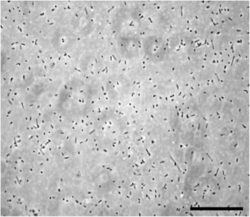Biology:Halorubrum lacusprofundi
| Halorubrum lacusprofundi | |
|---|---|

| |
| Scientific classification | |
| Domain: | |
| Kingdom: | |
| Phylum: | |
| Class: | Halobacteria
|
| Order: | |
| Family: | |
| Genus: | |
| Species: | H. lacusprofundi Franzmann et al. 1989[1]
|
| Binomial name | |
| Halorubrum lacusprofundi | |
| Synonyms | |
| |
Halorubrum lacusprofundi is a rod-shaped, halophilic Archaeon in the family of Halorubraceae. It was first isolated from Deep Lake in Antarctica in the 1980s.[3]
Genome
Several strains of H. lacusprofundi have been discovered. The genome sequencing of the strain ACAM 32 was completed in 2008. The organism's genome consists of two circular chromosomes and a single circular plasmid. Chromosome I contains 2,735,295 base pairs encoding 2,801 genes and chromosome II contains 525,943 base pairs encoding 522 genes. The single plasmid contains 431,338 base pairs encoding 402 genes.[4] At least one strain of H. lacusprofundi (R1S1) contains a plasmid (pR1SE) that enables horizontal gene transfer, which takes place via a mechanism that uses vesicle-enclosed virus-like particles.[5][6][7]
Research
Its β-galactosidase enzyme has been extensively studied to understand how proteins function in low-temperature, high-saline environments.[8][9]
References
- ↑ Page Species: Halorubrum lacusprofundi on "LPSN - List of Prokaryotic names with Standing in Nomenclature". Deutsche Sammlung von Mikroorganismen und Zellkulturen. https://lpsn.dsmz.de/species/halorubrum-lacusprofundi.
- ↑ Page Taxonomy browser (Halorubrum lacusprofundi) on "NCBI". https://www.ncbi.nlm.nih.gov/Taxonomy/Browser/wwwtax.cgi?mode=Info&id=2247.
- ↑ "Halobacterium lacusprofundii sp. nov., a halophilic bacterium isolated from Deep Lake, Antarctica". Systematic and Applied Microbiology 11 (1): 20–27. 1988. doi:10.1016/S0723-2020(88)80044-4.
- ↑ "Complete genome sequence of the Antarctic Halorubrum lacusprofundi type strain ACAM 34". Standards in Genomic Sciences 11 (1): 70. 2016. doi:10.1186/s40793-016-0194-2. PMID 27617060.
- ↑ "A plasmid from an Antarctic haloarchaeon uses specialized membrane vesicles to disseminate and infect plasmid-free cells". Nature Microbiology 2 (10): 1446–1455. 9 September 2017. doi:10.1038/s41564-017-0009-2. PMID 28827601.
- ↑ "Horizontal Gene Transfer in Archaea—From Mechanisms to Genome Evolution". Annual Review of Microbiology 76 (1): 481–502. 8 September 2022. doi:10.1146/annurev-micro-040820-124627. ISSN 0066-4227.
- ↑ "Influence of N-Glycosylation on Virus-Host Interactions in Halorubrum lacusprofundi". Viruses 15 (7): 1469. June 2023. doi:10.3390/v15071469. PMID 37515157.
- ↑ "Cloning, Overexpression, Purification, and Characterization of a Polyextremophilic β-galactosidase From the Antarctic Haloarchaeon Halorubrum lacusprofundi". BMC Biotechnol. 13: 10.1186/1472-6750-13-3. 2013. doi:10.1186/1472-6750-13-3. PMID 23320757.
- ↑ "Key amino acid residues conferring enhanced enzyme activity at cold temperatures in an Antarctic polyextremophilic β-galactosidase". PNAS 114 (47): 12530–35. 2017. doi:10.1073/pnas.1711542114. PMID 29109294. Bibcode: 2017PNAS..11412530L.
Wikidata ☰ Q25860604 entry
 |

